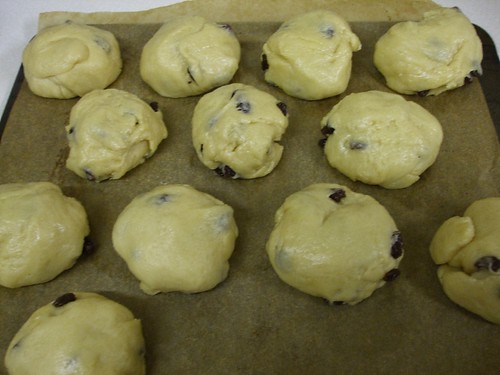 When we lived down in Cambridge we were frequent customers of the brilliant market stall called the Earth's Crust. They had excellent sourdough and rye breads, brilliant pastries (their chocolate and almond brioche made Sunday morning very special for me) and yummy cakes.
When we lived down in Cambridge we were frequent customers of the brilliant market stall called the Earth's Crust. They had excellent sourdough and rye breads, brilliant pastries (their chocolate and almond brioche made Sunday morning very special for me) and yummy cakes.Our sons were particularly fond of their Bath Buns, which is understandable because they are completely delicious, and toddler-satisfyingly huge.
So now we can't indulge at Earth's Crust any more, I thought it was about time that we had a go at making our own Bath Buns. This recipe is based on the one in Jane Grigson's English Food, which she got from Cobb & Co Ltd (I presume a bakers) of Bath. I've added sultanas, because my sons believe that all buns have some kind of dried fruit. I've also omitted some of the sugar in the bun in an attempt to cut down on the calories. These buns are incredibly rich, but I am unapologetic about that because everyone needs a treat now and again. They're definitely best eaten on the day they were made, preferably warm from the oven.
Bath Buns (makes 12 buns)
Ferment
10g dried yeast
10g granulated sugar
70g lukewarm water
4 eggs
75g strong white flour
Dough
450g strong white flour
180g softened butter cut into cubes
45g sugar
a pinch of mixed spice
a pinch of salt
150g sultanas
Bun wash and topping
30g sugar
3 tablespoons water
coarsely crushed sugar lumps, sugar crystals or granulated sugar
The buns start with a ferment which gives them a better flavour and results in a lighter dough - which is fairly essential for this very rich recipe. Put the yeast, sugar and water into a medium mixing bowl and whisk together to dissolve the yeast. Leave in a warm place for about 15 minutes until it has bubbled up. It will look something like this:

Beat the eggs in a separate bowl and then stir into your yeast mixture. Sift in the 75g of strong white flour and stir gently until combined. Cover the bowl with a damp tea-towel or cling film and leave in a warm place until the mixture has frothed up (this takes an hour or more depending on the temperature). You will have something that looks like this:

Put all the dough ingredients, except the sultanas, into a large bowl, gently add the ferment and mix it in using your hands or a mixer with a dough hook. It will seem impossibly sticky at first but patience is required. If you are doing this part by hand, as soon as you are able, turn the mixture onto a very lightly floured work surface and knead for about 10 minutes. If it does not show signs of losing it's stickiness at this stage add a little more flour (start with 1 tbsp). but don't rush into adding flour in the early stages. If you are using a mixer then mix for about 5 minutes. The finished dough should be smooth, a little sticky and will spring back when poked.
Flatten the dough to about 3cm thickness and press the sultanas into it, fold the dough over then press down again. Keep folding, pressing and kneading until the sultanas are fairly even distributed. You should end up with something like this:

Put the dough back in the bowl, cover the bowl with a damp tea-towel or clingfilm and leave in a warm place until it has doubled in size. Again, depending on the temperature this will take at least an hour, probably more like 2 hours for such a rich dough. Your risen dough will look like this:

Line a baking tray with baking parchment, or flour the tray thoroughly. Take your dough, and handling it gently, divide it into 12 pieces, each around the size of a small apple. Try and ensure that you don't have too many sultanas poking out through the dough because they will burn in the oven. Put the buns on the tray with a bit of space around them to allow them to rise:

Put the whole tray into a large carrier bag (I find 'Bags for Life' invaluable for this), making sure that the bag is not touching the buns, and put in a warm place until the buns have puffed up and are 'batching' (i.e. pushing up against each other). This will take anywhere between 30 minutes and an hour. Now is the time to preheat the oven to Gas 7/220C.
When the buns are ready to go in the oven, remove very carefully from the bag and bake them for around 15-20 minutes. Keep a close eye on them - the rich dough can burn quite quickly.
Whilst they are baking make the bun wash. Put the 30g of sugar and the water into a small saucepan and heat gently until the sugar is dissolved, then boil until the mixture is syrupy. Again, watch carefully, it is easy to get toffee at this stage! If using, crush the sugar lumps coarsely in a pestle and mortar.
When the buns are baked, remove from the oven and transfer to a cooling tray lined with a fresh sheet of baking parchment or greaseproof paper. Brush the tops of the buns with the syrupy bun wash and sprinkle with the sugar.
Leave to cool a bit and then enjoy - like this!

No comments:
Post a Comment